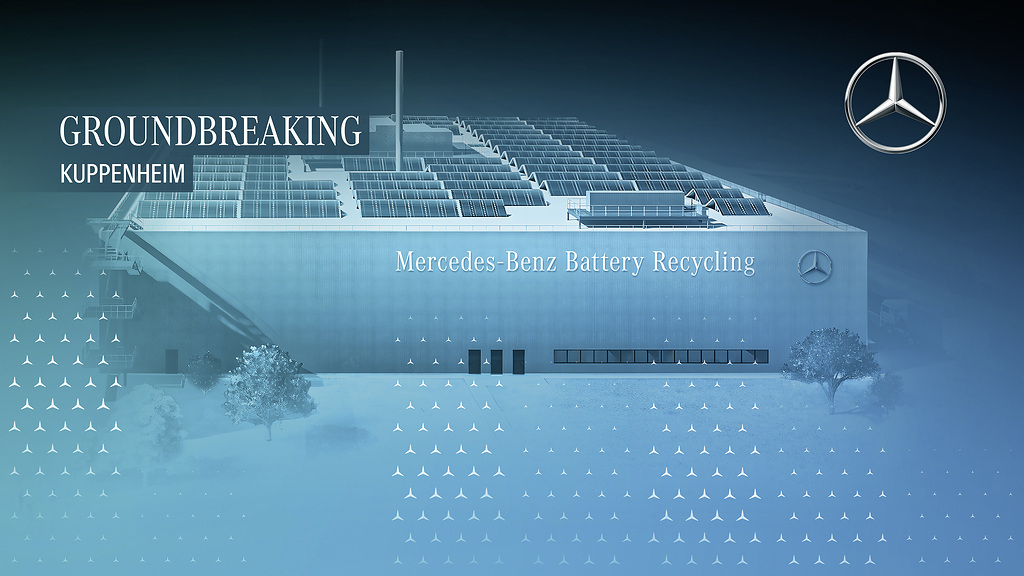
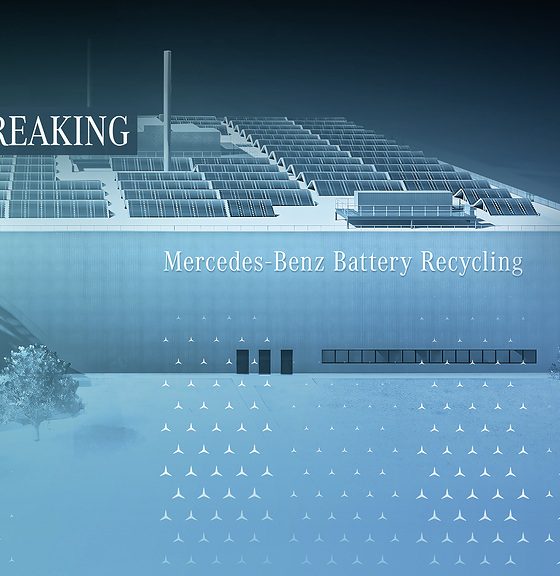
News
Mercedes breaks ground on new battery recycling facility in Germany
Mercedes has broken ground on a new battery recycling facility in Germany, focusing on “closing the loop” and allowing the automaker to source more battery materials sustainably.
Two of the biggest challenges in the industry of electric vehicles are the price of battery materials and what happens with batteries when they are at the end of their useable lives. Yet more and more manufacturers are finding that these two problems can help solve each other through the use of battery recycling. In efforts to source more materials more sustainably and cheaply, Mercedes has broken ground on its first battery recycling facility that will slowly ramp to help meet the automaker’s material demand.
Mercedes’ new facility in Kuppenheim, Germany, aims to achieve a remarkable 96% recovery rate for four key materials; lithium, cobalt, nickel, and eventually graphite. It will have an annual recycling capacity of 2,500 tons and aims to begin processing by the end of this year.
“This foundation symbolizes the decisive step towards closing the material cycle for batteries from Mercedes-Benz,” says Jörg Burzer, Member of the Board of Management at Mercedes-Benz. “With a recycling rate of more than 96 percent, a ‘mine of tomorrow’ is being created here in Kuppenheim. The innovative technology approach enables us to incorporate the valuable raw materials into new Mercedes-EQ vehicles. We are consistently expanding our expertise of the battery value chain and are taking an important step in our strategy towards ‘Electric Only.’”
Mercedes also specifies that the new facility will be 100% carbon neutral as part of the German automaker’s continuing efforts to decarbonize its production facilities in the coming years. This is achieved through a mix of solar energy installed at the facility and green energy purchased from the grid.
German regulators were quick to point out that the new facility will also be a vital part of the country’s efforts to limit dependence on rare earth imports, which were particularly affected on the European continent due to the COVID pandemic, COVID restrictions in China, and the Rissian invasion of Ukraine.
“This is of particular importance in view of the limited availability of important and highly sought-after raw materials such as lithium, cobalt or nickel,” noted Thekla Walker, Minister for the Environment, Climate Protection and the Energy Sector Baden-Württemberg. “Crises such as the corona pandemic or the brutal Russian war of aggression against Ukraine have clearly demonstrated our dependence on supply chains and primary raw materials. Increased recycling can help to reduce this dependence on critical raw materials and thus strengthen the resilience of the economy.”
Mercedes joins the likes of Tesla, General Motors, and many others, establishing battery recycling capabilities worldwide. Tesla has already announced that it would make recycled materials a bigger part of its production with the help of Redwood materials. General Motors has worked closely with Lithion to establish battery recycling as part of its planned introduction of numerous EVs in the near future. While at the same time, national governments are also incentivizing many of these projects to help reduce the waste that could become an issue in a wholly electrified future.
Late last month, the U.S. Department of Energy granted one of its first-ever lithium battery recycling loans to a battery recycler in Upstate New York, LiCycle. And with the growing need for this infrastructure, the agency is expected to continue to invest in the future.
As Mercedes rapidly grows the number of electric vehicles it sells globally over the coming years, battery recycling plants like this will be critical to its growth and success. Hopefully, it can pose as an example for other manufacturers moving forward, helping to make EVs increasingly more sustainable.
What do you think of the article? Do you have any comments, questions, or concerns? Shoot me an email at william@teslarati.com. You can also reach me on Twitter @WilliamWritin. If you have news tips, email us at tips@teslarati.com!

News
Tesla tinkering with Speed Profiles on FSD v14.2.1 has gone too far

Tesla recently released Full Self-Driving (FSD) v14.2.1, its latest version, but the tinkering with Speed Profiles has perhaps gone too far.
We try to keep it as real as possible with Full Self-Driving operation, and we are well aware that with the new versions, some things get better, but others get worse. It is all part of the process with FSD, and refinements are usually available within a week or so.
However, the latest v14.2.1 update has brought out some major complaints with Speed Profiles, at least on my end. It seems the adjustments have gone a tad too far, and there is a sizeable gap between Profiles that are next to one another.
Tesla FSD v14.2.1 first impressions:
✅ Smooth, stress-free highway operation
✅ Speed Profiles are refined — Hurry seems to be limited to 10 MPH over on highways. Switching from Mad Max to Hurry results in an abrupt braking pattern. Nothing of concern but do feel as if Speed…— TESLARATI (@Teslarati) November 29, 2025
The gap is so large that changing between them presents a bit of an unwelcome and drastic reduction in speed, which is perhaps a tad too fast for my liking. Additionally, Speed Profiles seem to have a set Speed Limit offset, which makes it less functional in live traffic situations.
Before I go any further, I’d like to remind everyone reading this that what I am about to write is purely my opinion; it is not right or wrong, or how everyone might feel. I am well aware that driving behaviors are widely subjective; what is acceptable to one might be unacceptable to another.
Speed Profiles are ‘Set’ to a Speed
From what I’ve experienced on v14.2.1, Tesla has chosen to go with somewhat of a preset max speed for each Speed Profile. With ‘Hurry,’ it appears to be 10 MPH over the speed limit, and it will not go even a single MPH faster than that. In a 55 MPH zone, it will only travel 65 MPH. Meanwhile, ‘Standard’ seems to be fixed at between 4-5 MPH over.
This is sort of a tough thing to have fixed, in my opinion. The speed at which the car travels should not be fixed; it should be more dependent on how traffic around it is traveling.
It almost seems as if the Speed Profile chosen should be more of a Behavior Profile. Standard should perform passes only to traffic that is slower than the traffic. If traffic is traveling at 75 MPH in a 65 MPH zone, the car should travel at 75 MPH. It should pass traffic that travels slower than this.
Hurry should be more willing to overtake cars, travel more than 10 MPH over the limit, and act as if someone is in a hurry to get somewhere, hence the name. Setting strict limits on how fast it will travel seems to be a real damper on its capabilities. It did much better in previous versions.
Some Speed Profiles are Too Distant from Others
This is specifically about Hurry and Mad Max, which are neighbors in the Speed Profiles menu. Hurry will only go 10 MPH over the limit, but Mad Max will travel similarly to traffic around it. I’ve seen some people say Mad Max is too slow, but I have not had that opinion when using it.
In a 55 MPH zone during Black Friday and Small Business Saturday, it is not unusual for traffic around me to travel in the low to mid-80s. Mad Max was very suitable for some traffic situations yesterday, especially as cars were traveling very fast. However, sometimes it required me to “gear down” into Hurry, especially as, at times, it would try to pass slower traffic in the right lane, a move I’m not super fond of.
We had some readers also mention this to us:
The abrupt speed reduction when switching to a slower speed profile is definitely an issue that should be improved upon.
— David Klem (@daklem) November 29, 2025
After switching from Mad Max to Hurry, there is a very abrupt drop in speed. It is not violent by any means, but it does shift your body forward, and it seems as if it is a tad drastic and could be refined further.
News
Tesla’s most affordable car is coming to the Netherlands
The trim is expected to launch at €36,990, making it the most affordable Model 3 the Dutch market has seen in years.
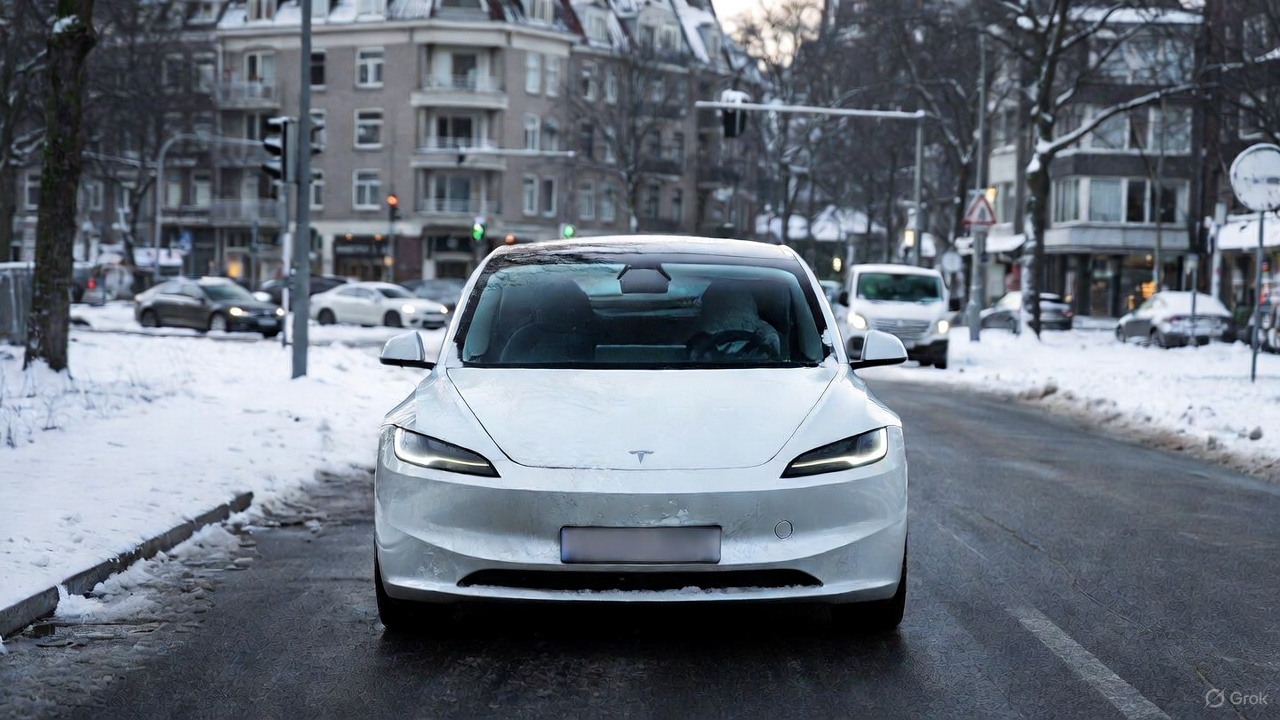
Tesla is preparing to introduce the Model 3 Standard to the Netherlands this December, as per information obtained by AutoWeek. The trim is expected to launch at €36,990, making it the most affordable Model 3 the Dutch market has seen in years.
While Tesla has not formally confirmed the vehicle’s arrival, pricing reportedly comes from a reliable source, the publication noted.
Model 3 Standard lands in NL
The U.S. version of the Model 3 Standard provides a clear preview of what Dutch buyers can expect, such as a no-frills configuration that maintains the recognizable Model 3 look without stripping the car down to a bare interior. The panoramic glass roof is still there, the exterior design is unchanged, and Tesla’s central touchscreen-driven cabin layout stays intact.
Cost reductions come from targeted equipment cuts. The American variant uses fewer speakers, lacks ventilated front seats and heated rear seats, and swaps premium materials for cloth and textile-heavy surfaces. Performance is modest compared with the Premium models, with a 0–100 km/h sprint of about six seconds and an estimated WLTP range near 550 kilometers.
Despite the smaller battery and simpler suspension, the Standard maintains the long-distance capability drivers have come to expect in a Tesla.
Pricing strategy aligns with Dutch EV demand and taxation shifts
At €36,990, the Model 3 Standard fits neatly into Tesla’s ongoing lineup reshuffle. The current Model 3 RWD has crept toward €42,000, creating space for a more competitive entry-level option, and positioning the new Model 3 Standard comfortably below the €39,990 Model Y Standard.
The timing aligns with rising Dutch demand for affordable EVs as subsidies like SEPP fade and tax advantages for electric cars continue to wind down, EVUpdate noted. Buyers seeking a no-frills EV with solid range are then likely to see the new trim as a compelling alternative.
With the U.S. variant long established and the Model Y Standard already available in the Netherlands, the appearance of an entry-level Model 3 in the Dutch configurator seems like a logical next step.
News
Tesla Model Y is still China’s best-selling premium EV through October
The premium-priced SUV outpaced rivals despite a competitive field, while the Model 3 also secured an impressive position.
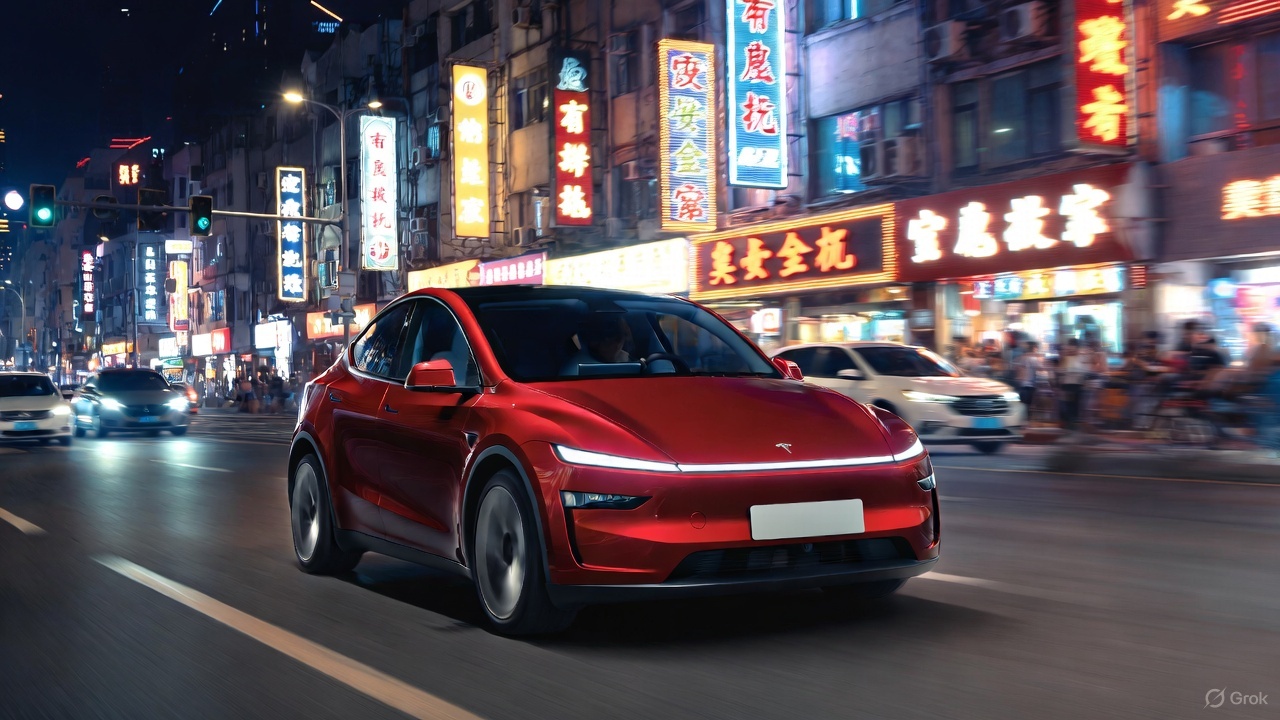
The Tesla Model Y led China’s top-selling pure electric vehicles in the 200,000–300,000 RMB segment through October 2025, as per Yiche data compiled from China Passenger Car Association (CPCA) figures.
The premium-priced SUV outpaced rivals despite a competitive field, while the Model 3 also secured an impressive position.
The Model Y is still unrivaled
The Model Y’s dominance shines in Yiche’s October report, topping the chart for vehicles priced between 200,000 and 300,000 RMB. With 312,331 units retailed from January through October, the all-electric crossover was China’s best-selling EV in the 200,000–300,000 RMB segment.
The Xiaomi SU7 is a strong challenger at No. 2 with 234,521 units, followed by the Tesla Model 3, which achieved 146,379 retail sales through October. The Model Y’s potentially biggest rival, the Xiaomi YU7, is currently at No. 4 with 80,855 retail units sold.

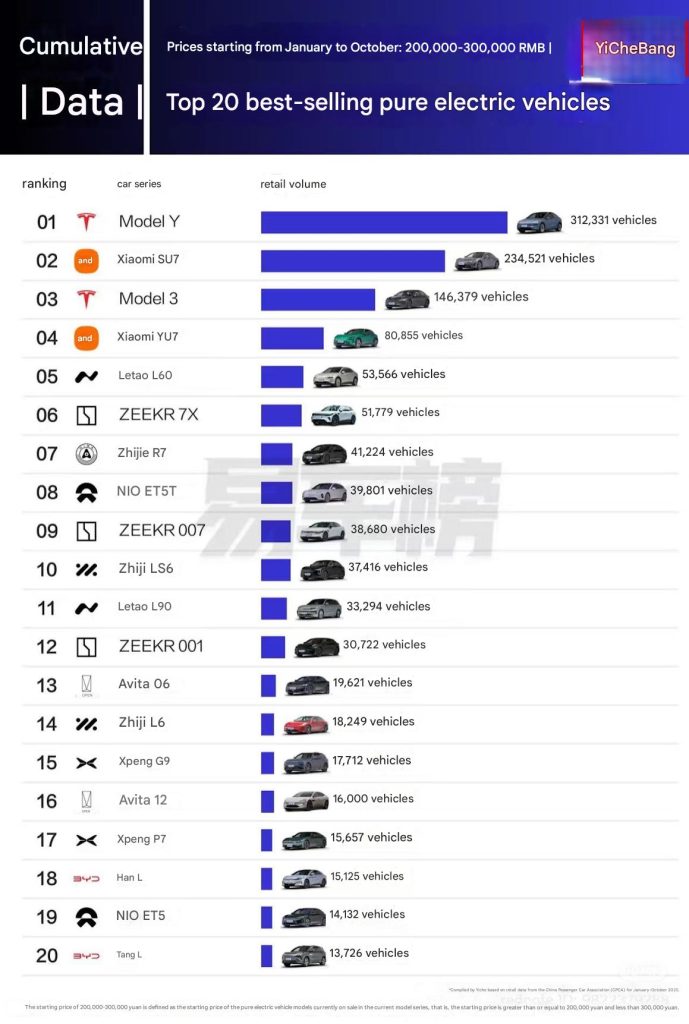
Efficiency kings
The Model 3 and Model Y recently claimed the top two spots in Autohome’s latest real-world energy-consumption test, outperforming a broad field of Chinese-market EVs under identical 120 km/h cruising conditions with 375 kg payload and fixed 24 °C cabin temperature. The Model 3 achieved 20.8 kWh/100 km while the Model Y recorded 21.8 kWh/100 km, reaffirming Tesla’s efficiency lead.
The results drew immediate attention from Xiaomi CEO Lei Jun, who publicly recognized Tesla’s advantage while pledging continued refinement for his brand’s lineup.
“The Xiaomi SU7’s energy consumption performance is also very good; you can take a closer look. The fact that its test results are weaker than Tesla’s is partly due to objective reasons: the Xiaomi SU7 is a C-segment car, larger and with higher specifications, making it heavier and naturally increasing energy consumption. Of course, we will continue to learn from Tesla and further optimize its energy consumption performance!” Lei Jun wrote in a post on Weibo.









